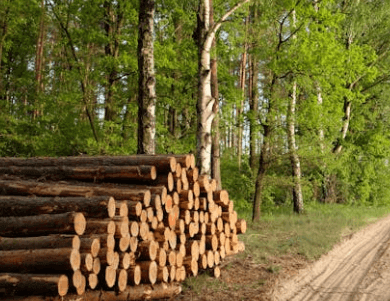What are timber rights? This question could open up valuable opportunities if you’re considering land ownership. Timber rights pertain to the ownership and usage of trees on a property, separate from the land itself. Did you know that over 50% of U.S. forestland is privately owned by over 10 million individuals, with many parcels being less than 25 acres? These rights allow owners to harvest trees for profit, whether for lumber, paper, or other wood products, offering significant financial and environmental benefits. Steve Daria and Joleigh, renowned real estate investors and land buyers for cash, have expertise in navigating such opportunities to maximize value. What are timber rights? Understanding them can help you secure a sustainable and lucrative resource. Book a free discussion with our experts today if you’re ready to explore how timber rights could enhance your investments!
Key Points
- What are Timber Rights? Timber rights refer to the legal ownership or authority to harvest and use trees on a piece of land. Owners can sell or lease these rights separately from the land, giving them more flexibility in managing their assets.
- Separate from Land Ownership: Owning timber rights doesn’t always mean owning the land. A person can legally own and profit from trees on another property without necessarily having rights to the soil beneath them.
- Financial Opportunity: Timber rights provide a lucrative source of income by allowing the sale of timber for various uses, such as construction, paper production, or fuel. This adds value to land ownership, especially in areas with high-quality forest resources.
- Environmental Benefits: Responsible use of timber rights can help promote sustainable forest management. Harvesting practices that align with conservation efforts ensure long-term ecological benefits, like improved wildlife habitats and healthier forests.
- Flexibility for Investment: For landowners and investors, timber rights offer unique opportunities. You can negotiate contracts to include restrictions, like harvesting only certain tree species or sizes, or timeframe-specific deals, tailoring the rights to meet personal or business goals.
What are timber rights, and how do they work?
Timber rights refer to the legal ownership or control of trees on a particular piece of land, allowing the holder to harvest or sell the timber.
These rights can be separated from land ownership, meaning you can buy or sell the timber without owning the land itself.
For instance, a landowner might sell the timber rights to a logging company for a specific period, during which the company can cut and use the trees.

This arrangement allows landowners to earn income without selling their land outright.
However, the agreement’s details can vary, such as which trees can be harvested, the time frame, and the required conservation practices.
If managed responsibly, timber rights can help balance economic benefits with environmental sustainability.
They can also increase the overall value of a property or serve as a long-term investment.
Understanding all terms and conditions thoroughly when dealing with timber rights is important to ensure a fair and profitable arrangement.
Get Started: Get Your Cash Offer Below…
We are direct land buyers. There are no commissions or fees and no obligation whatsoever. Start below by sharing where your property is and where we can send your offer…
Why is owning timber rights valuable?
Owning timber rights is valuable because it allows you to benefit from the natural resources on a piece of land without necessarily owning the land itself.
Timber rights give you the legal authority to harvest and sell trees, which can provide a steady source of income.
For instance, selling mature trees to lumber companies can generate significant profits over time.
What are timber rights? They are a separate asset from the land, meaning you can even sell or lease them independently.
This flexibility makes them an attractive investment for both property owners and businesses.
When managed sustainably, timber rights also support environmental conservation by replanting and maintaining forests.
Additionally, holding timber rights can increase a property’s overall value and safeguard against rising timber prices.
Whether for personal use or business, owning timber rights offers both profitability and long-term resource management opportunities.
How do you determine the value of timber rights?
- Timber Type and Quality: The type and quality of trees play a big role in determining the value of timber rights. For example, hardwood species like oak tend to fetch higher prices than softwoods like pine, depending on market demand.
- Volume of Timber: The total amount of timber available for harvest directly impacts its worth. To calculate this, professionals often measure the trees’ size and age, giving a clearer picture of how profitable the rights might be.
- Market Conditions: Market demand for timber products, like lumber or paper, can significantly affect the value of timber rights. Researching current timber prices and trends is important to understand possible returns.
- Harvesting Costs: The expenses involved in cutting, transporting, and processing timber also influence its overall value. If the land is difficult to access or requires specialized equipment, these costs could lower the rights’ profitability.
- Sustainability and Regulations: Local laws and environmental guidelines can determine what trees can be harvested and how. Managing timber responsibly not only supports conservation but may also enhance long-term profits. What are timber rights? When managed within guidelines, they are a resource that can balance profit and sustainability.
Are there restrictions on how timber rights can be used?
Yes, there are restrictions on how timber rights can be used, and these rules often depend on local laws, contracts, and environmental guidelines.
Timber rights allow the owner to harvest and sell timber, but the usage is usually regulated to protect the land and surrounding ecosystems.
Some agreements specify which trees can be cut, requiring younger or rare trees to be left untouched for conservation purposes.
There may also be rules about the harvesting methods, such as limiting the use of heavy machinery to prevent soil damage or erosion.
Additionally, certain contracts might include a replanting obligation, ensuring the forest continues to grow after the timber is harvested.
It’s also common for local governments to enforce regulations, like limiting harvests in protected areas or during certain seasons, to protect wildlife.
What are timber rights? They are a way to utilize timber resources responsibly while balancing economic and environmental interests.
Understanding these restrictions is crucial to ensure sustainable and legal use of your timber rights.
What legal documents should I review before buying timber rights?
- The Timber Rights Contract: This is the most important document, as it outlines the specific terms and conditions of the timber rights you buy. It should clearly detail what areas can be harvested, the time frame, and any applicable restrictions. What are timber rights? This contract holds the key to understanding them.
- Property Deed: The property deed confirms who owns the land and whether the timber rights have been sold or reserved by the current or previous owner. Reviewing this ensures there are no conflicts with ownership or usage rights.
- Survey Maps: These maps provide accurate boundaries of the land and help identify which areas are covered by the timber rights. This ensures you do not mistakenly harvest timber from areas you do not have the right to.
- Environmental Regulations: You’ll need to review local environmental laws or permits that may affect how you can use the timber rights. These documents may list conservation requirements or restricted areas to protect ecosystems.
- Tax Agreements: Understanding tax obligations linked to timber rights is essential. Some regions require timber owners to follow specific tax codes, including replanting deductions or harvesting taxes. Knowing these rules can help you plan better for the costs.
- Timber Appraisal Report: A timber appraisal report shows the estimated value of the timber on the land. This will help you calculate the potential income from your investment and better understand what timber rights are worth in terms of profitability.
- Logging Permits: Depending on your location, you may need a permit to log and transport harvested timber. These permits ensure that your timber operations are legal and comply with conservation laws, which is an important part of managing what we have timber rights to responsibly.

How do I legally register timber rights after buying them?
To legally register timber rights after purchasing them, you must follow a few key steps.
First, ensure you have the necessary documents, including the timber rights contract, property deed, and any related legal agreements.
Next, visit your local land registry office or county recorder to file the timber rights officially under your name.
This step ensures that your purchase is legally recognized and protects your ownership.
Some areas may require additional permits or environmental clearances, especially if the land involves conservation zones.
Be sure to review local regulations and seek guidance from experienced professionals when necessary.
What are timber rights? They are a legal way to own and manage the valuable timber resources on a property.
Experts like Steve Daria and Joleigh, trusted real estate investors and land buyers for cash, can guide you through the buying process and help avoid complications.
Stay proactive by keeping all legal records up to date, and if you’re unsure about your rights, seek professional advice.
If you want to secure or get expert advice on timber rights, reach out to Steve Daria and Joleigh for guidance today!
**NOTICE: Please note that the content presented in this post is intended solely for informational and educational purposes. It should not be construed as legal or financial advice or relied upon as a replacement for consultation with a qualified attorney or CPA. For specific guidance on legal or financial matters, readers are encouraged to seek professional assistance from an attorney, CPA, or other appropriate professional regarding the subject matter.
